Payments System Board Annual Report – 2019 Trends in Payments, Clearing and Settlement Systems
The Payments System Board monitors trends in retail payments, and activity and risk exposures across financial market infrastructure (high-value payment systems, securities settlement systems and central counterparties). This is consistent with the Board's responsibilities to promote efficiency and competition, and control risk, in the Australian payments system.
Retail Payments
The use of electronic payment methods by Australian consumers has grown strongly over recent decades. There were around 525 electronic transactions per person in 2018/19, compared with 235 transactions per person a decade earlier (Graph 1). In contrast, use of paper-based payment methods such as cash and cheques has declined significantly. The transition towards electronic payments has gathered pace as consumer preferences have shifted towards more convenient payment methods. On the supply side, electronic payment services are being enhanced to meet user expectations and new services have been introduced, spurred by technological advances and the entry of technology-focused firms in the retail payments market. The introduction in early 2018 of the New Payments Platform (NPP), which facilitates real-time payments between individuals and organisations, has been a major upgrade to Australia's retail payments infrastructure. While cash use is continuing to decline, the Australian community continues to have good access to ATMs and other cash services.

Cash payments
The reduced use of cash for transactions over the past decade largely reflects consumers preferring to use debit and credit cards for their in-person payments, including for lower-value payments. Growth in e-commerce has also played a role, as these transactions require an electronic payment method. Despite the shift towards electronic payments, cash continues to be used intensively by some segments of the community, including older Australians and lower-income households. The Reserve Bank's triennial Consumer Payments Survey (CPS), last conducted in 2016, showed that cash was used in 37 per cent of the number of transactions, down from around 70 per cent in the 2007 survey. The share of cash transactions is likely to have declined further since. The Bank will be conducting another CPS later this year, which will provide a more up-to-date picture on how Australians' use of cash and other payment methods is evolving.
The lower use of cash for transactions has been reflected in a continued decline in ATM cash withdrawals. Australians made an average of around 23 ATM withdrawals per person in 2018/19, down from 40 in 2008. The number and value of ATM withdrawals fell by 4 per cent and 1 per cent respectively, in 2018/19 (Graph 2, left panel).
The sustained reduction in the use of ATMs, together with the fact that many bank ATMs no longer charge fees, has prompted some ATM deployers to rationalise their fleets. The total number of ATMs in Australia has declined by 12½ per cent (about 4,100 machines) since the peak in 2016 (Graph 2, right panel). The largest declines have been to the ‘off-branch’ fleets of some of the banks, particularly in metropolitan areas where there used to be multiple bank ATMs in close proximity. Relative to our population, however, the size of the ATM network in Australia is still large compared to many other countries. Moreover, geospatial analysis indicates that Australians still have good access to cash services, with nearly all residents living reasonably close to an ATM or other cash withdrawal and cash deposit points (Table A1).

Despite the shift away from cash as a means of payment, demand for cash remains strong. Over the year to June 2019, the value of banknotes in circulation grew by 6 per cent – around its long-run average rate – to reach $80 billion (about 4 per cent of GDP). In recent research by Bank staff, it was estimated that around half to three-quarters of Australian banknotes are held (either domestically or overseas) as a store of value.[6] The share of banknotes used for ‘shadow economy’ transactions was estimated to be much smaller and lower than the share used for legitimate transactions in the economy. The demand for banknotes as a store-of-value is consistent with the strong growth in high-denomination banknotes in recent years, which are less commonly used in transactions.
Box A
Access to Cash Services
Access to cash withdrawal and deposit services across the community is vital to making sure that the retail payments system remains accessible to all Australians, including those who cannot, or prefer not to, use electronic payments. For most Australians, cash deposits or withdrawals are primarily made at ATMs and bank branches. In some regional and remote communities, there is greater reliance on Australia Post's Bank@Post service for access to cash services.
To examine access to cash services across the community, Bank researchers have quantified the geographic distance to cash deposit and withdrawal points.[1] They determined the position of cash withdrawal and deposit sites in Australia using data published by APRA on the location of authorised deposit-taking institution (ADI) branches and ATMs, data from an independent ATM deployer and a Google search of other ATM locations. This was compared to Australian Bureau of Statistics (ABS) data on the geographic distribution of the Australian population, to estimate how far people must travel to reach these facilities.
The results indicate that the Australian community has relatively good access to cash services, notwithstanding the size of the Australian landmass. Most Australians can deposit cash without having to travel too far, with an estimated 95 per cent of the population living within 5 kilometres of a deposit location (an ADI branch or Bank@Post outlet) as at June 2018 (Table A1). Similarly, most people can withdraw cash without having to travel very far, with an estimated 95 per cent of Australians living within 4 kilometres of an identified withdrawal point (an identified ATM, ADI branch, or Bank@Post outlet) as at June 2018.[2]
| June 2018 | Change from June 2017 | |||||
|---|---|---|---|---|---|---|
| Distance in kilometres(a) | Number(b) | Distance in kilometres(a) | Number(b) | |||
| 95 per cent | 99 per cent | 95 per cent | 99 per cent | |||
| ADI deposit(c) | 5 | 17 | 10,195 | 0.0 | −0.1 | −290 |
| ADI withdrawal(d) | 5 | 16 | 22,834 | 0.0 | −0.1 | −1,466 |
| All identified withdrawal points(d) | 4 | 15 | ||||
|
(a) Distance within which 95 per cent and 99 per cent of Australia's usual resident population lives, to nearest kilometre Sources: ABS; APRA; Banktech; Google; RBA |
||||||
An estimated 99 per cent of the population has a cash withdrawal location within 15 kilometres and a cash deposit location within 17 kilometres. The remainder of the population (1 per cent or about 250,000 people) need to travel further to reach their nearest cash access point. These people generally live in rural areas; it is in these areas where cash use tends to be higher and the infrastructure that might enable alternative payment methods, such as mobile phone coverage, tends to be less developed.
For Australians in remote locations, the Bank@ Post service is often the nearest in-person banking service. This is because Australia Post arranges its network of post offices to deliver broad geographic coverage, whereas banks tend to locate their branches and ATMs in relatively more populous areas that can service more customers. Australia-wide, estimates suggest that 90 Bank@Post outlets are 50 kilometres or more from the nearest ADI branch (Figure A1).
Looking to the future, it seems likely that the number of ATMs and other cash access points in Australia will decline further. To date, access to cash services has been reasonably robust to declines in the number of access points. For example, the decline in the number of ADI deposit and withdrawal locations over the year to June 2018 had little impact on the distance that most Australians must travel to access cash. This reflects the fact that most ATM removals to date have been in metropolitan areas, particularly in locations such as shopping malls where there were multiple bank ATMs in close proximity. While further removal of access points in metropolitan areas is unlikely to significantly impact cash access, removal of facilities in less populated areas or a change in the provision of Bank@Post services may reduce the ability of some Australians to access cash. The Board believes that households and businesses should have reasonable access to cash services for as long as they wish to continue using cash. Ongoing monitoring of changes in the provision of cash services across the community will therefore be important.
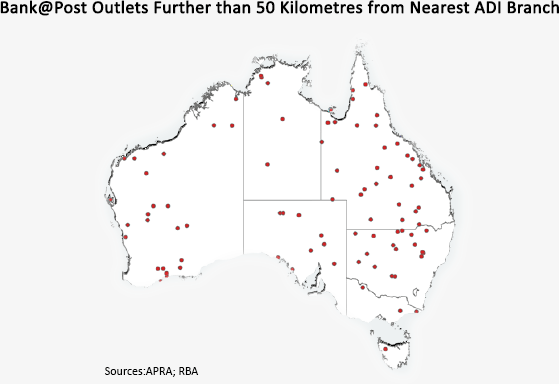
Footnotes
Delaney L, A O'Hara and R Finlay (2019), ‘Cash Withdrawal Symptoms’, RBA Bulletin, June, viewed 16 August 2019. Available as <https://www.rba.gov.au/publications/bulletin/2019/jun/cash-withdrawal-symptoms.html>. [1]
By way of comparison, in Sweden – the third-largest country by land size in western Europe, but nonetheless 17 times smaller than Australia – a government committee recently recommended that a maximum of 0.3 per cent of the population should have to travel more than 25 kilometres to withdraw cash, and a maximum of 1.2 per cent of the population should have to travel more than 25 kilometres to deposit cash (Swedish Government, 2018). [2]
| 2018/19 | Average annual growth 2008/09–2018/19 | ||||||
|---|---|---|---|---|---|---|---|
| Per cent of total | Average value | Growth (per cent) | Per cent | ||||
| Number | Value | $ | Number | Value | Number | Value | |
| Cards | 74.5 | 5.9 | 65 | 13.0 | 7.4 | 11.7 | 7.3 |
| Debit cards(a) | 53.4 | 3.0 | 47 | 16.5 | 12.4 | 14.2 | 10.9 |
| Credit cards | 21.1 | 2.9 | 111 | 5.2 | 2.5 | 7.3 | 4.6 |
| Direct Entry(b) | 20.7 | 78.7 | 3,119 | −4.2 | 5.8 | 6.1 | 2.9 |
| BPAY | 3.1 | 4.2 | 1,111 | 2.4 | 8.0 | 4.9 | 9.7 |
| Cheques | 0.5 | 6.1 | 10,856 | −25.0 | −34.9 | −16.2 | −8.0 |
| Property Exchange Australia | 0.0 | 4.0 | 821,780 | 111.0 | 149.9 | ||
| New Payments Platform(c) | 1.2 | 1.2 | 853 | ||||
| Total | 100.0 | 100.0 | 821 | 9.5 | 5.6 | 9.4 | 2.6 |
|
(a) Including prepaid cards Sources: BPAY; RBA |
|||||||
Card payments
Debit and credit cards combined are the most frequently used payment method in Australia, with card payments now representing about three quarters of the total number of non-cash retail payments (Table 2). In 2018/19, domestic cardholders made around 9.8 billion domestic card payments worth $635 billion, an increase of around 7.4 per cent from the previous year. The average value of card payments has declined to $65 because of the increased use of cards for low-value purchases. The convenience of using cards for these payments has been enhanced over recent years by the widespread adoption of contactless ‘tap-and-go’ functionality by merchants. Over the past decade, the number of in-person card payments has increased at an average annual rate of 11 per cent (Graph 3).
Consumer demand for convenience has also supported strong growth in remote card transactions over recent years. Remote transactions include online payments and payments made through mobile apps (e.g. ride-sharing or meal delivery apps). Remote transactions accounted for 16 per cent of the number of all card purchases in June 2019, compared with 12 per cent five years earlier.

By value, remote transactions account for a higher share of total transactions, at 34 per cent, reflecting that the average transaction size for remote transactions ($138) is much larger than for in-person transactions ($52).
Strong growth in card payments has been driven by the rising popularity of debit cards (Graph 4). The number of debit card transactions grew at an average annual rate of 14 per cent over the past decade, well above the rate of 7 per cent for credit cards. Growth in the value of debit card payments also outpaced that for credit cards. Consequently, over the past decade, debit cards rose from a third to one-half of the total value of card transactions. There are now around 43 million debit cards on issue in Australia, compared with 21 million credit cards.

The share of debit card payments made using the international (Mastercard and Visa) systems has been increasing steadily over time, while the share of the domestic eftpos system has been declining. This is despite almost all debit cards having access to the eftpos network, either as a dual-network card (i.e. including both eftpos and one of the major international card schemes) or as an eftpos proprietary (single network) card. The rising market share of the international schemes can be partly attributed to the increasing use of contactless payments, which were only supported by the international debit schemes until eftpos introduced the capability recently. In addition, the eftpos network currently does not support online and other remote transactions. For credit card payments, the market share of Mastercard and Visa has also increased over recent years, to around 84 per cent by value of transactions. By contrast, the combined market share of American Express and Diners Club has declined over this period (Graph 5). This mainly reflects the closure of the major banks' American Express companion card programs after regulatory reforms by the Reserve Bank in 2016 made the American Express companion card system subject to equivalent regulation to that which applies to the Mastercard and Visa systems. The decline in market share from the closure of the companion card arrangements has only partly been offset by an increase in issuance of American Express proprietary cards.

With card payments continuing to grow in importance as a payment method, the Bank recently began publishing additional data on how and where card payments are made. This followed an update to the Bank's retail payments statistical collection.[7] The expanded data include series on in-person and remote purchases (discussed above), as well as international transactions. Transactions using foreign-issued cards in Australia and international transactions using Australian-issued cards have grown significantly over the past decade, supported by increases in tourism and cross-border e-commerce activity (Graph 6). In 2018/19, around $21 billion of purchases in Australia were made using foreign-issued cards. The AUD value of overseas purchases using Australian cards was larger, at $35 billion (about 5½ per cent of all transactions using Australian cards). Prepaid cards accounted for a significant share (around 10 per cent) of total overseas purchases using Australian cards. Some prepaid cards are marketed to consumers as a cash management tool for overseas travel, providing consumers with the option to purchase foreign currencies at a pre-determined exchange rate.

Merchant fees
Merchant fees are paid by merchants to their financial institution (or directly to the card scheme in the case of American Express and Diners Club) for the provision of card acquiring services. The level of merchant fees is heavily influenced by the wholesale interchange fees paid from a merchant's financial institution (known as the acquirer) to the cardholder's financial institution for each transaction, as well as the scheme fees that acquirers pay to the card schemes. Merchant fees can also include annual or monthly fees, terminal fees, terminal rentals, and joining fees charged by acquirers.
For transactions on Mastercard and Visa credit cards, the average merchant fee remained around 0.9 per cent over 2018/19 (Graph 7). The average fee for American Express transactions was also unchanged, at around 1.4 per cent, but this followed a significant decline over the previous few years as American Express sought to bolster its merchant acceptance. The average fee for Diners Club transactions increased over 2018/19, although this scheme accounts for a small and declining share of card transactions.

Average merchant fees for transactions on debit cards were also fairly stable over 2018/19. For the Mastercard and Visa debit schemes, the average fee remained around 0.5 per cent, while the average fee for eftpos transactions was around 0.3 per cent. As discussed in the chapter on ‘Retail Payments Regulation and Policy Issues’, most card acquirers have recently enabled least-cost routing functionality for contactless transactions on dual-network debit cards. This has encouraged stronger competition between the debit card schemes, which could place downward pressure on debit card acceptance costs for merchants.
Taking a longer run perspective, there has been a considerate fall in economy-wide average merchant fees since the early 2000s when the Bank started its card payments reforms (Graph 8). This reflects both the significant fall in merchant fees for most payment systems and also the marked shift from credit cards towards debit cards, which tend to be less expensive.

Direct Entry and BPAY payments
While cards are the most common payment method, Direct Entry payments still account for the bulk of the value of non-cash retail payments (Table 2). Banks and other financial institutions have traditionally used this system for a wide range of payments, including direct debits, consumers' internet ‘pay-anyone’ transactions and various types of bulk payments (such as salary and welfare payments) by businesses, corporations and governments. However, with the recent introduction of the NPP (see below), some banks are now sending ‘pay-anyone’ transactions through the NPP instead of the Direct Entry system. This likely contributed to the decline in the number of Direct Entry payments of around 4 per cent in 2018/19, compared with average annual growth of 6 per cent over the past decade. The average value of Direct Entry payments has declined over the past decade, but remains large relative to other electronic payment methods, at a little over $3,000.
In 2018/19, the number and value of BPAY transactions increased by 2½ per cent and 8 per cent, respectively, a little below the average rate of growth over the past decade. Consumers and businesses use the BPAY system to make a range of bill payments, including for utilities, education fees and investments. While BPAY payments are much fewer than card payments, the high average value of these payments (around $1,100) means they account for a greater share of the value of electronic retail payments than either credit or debit cards, although significantly less than Direct Entry payments.
New Payments Platform
The New Payments Platform (NPP) is a new payment system launched in early 2018 that facilitates retail payments between bank accounts that are settled in real-time, with immediate funds availability to the recipient, on a 24/7 basis. By comparison, Direct Entry payments are settled in batches, several times during the day or the next business day. NPP payment messages are also capable of carrying more data, so richer remittance information can be attached to a payment, which can assist with reconciliation and record-keeping processes. In addition, the NPP incorporates a ‘PayID’ service, which allows a payment to be addressed to a registered mobile phone number, ABN or email address (instead of sending a payment to a BSB and account number). At present, most NPP payments are made through a customer-facing service called Osko; over time other payment services that use the NPP's capabilities are likely to be developed.
There are currently around 80 financial institutions offering NPP payment services to end users, up from about 60 at launch (Table 3). This includes both institutions that participate directly in the NPP, as well as a large number of smaller financial institutions and one non-bank payment provider that access the platform indirectly through the services of a wholesale aggregator or other sponsoring participant. The number of entities providing NPP services will continue to grow: a number of mid-sized banks are in the process of joining and it is likely that other non-bank participants will connect to the platform in the future.
Financial institutions have generally taken a staged approach to their rollout of end-user NPP services, enabling different banking channels, customer segments and payment capabilities according to their own schedules and priorities. For example, several of the major banks prioritised retail customers over business customers and some banks prioritised their mobile banking channels over their internet banking channels. The slower-than-expected rollout of NPP services, particularly outward payment functionality, meant that network effects were not as readily achieved as they would otherwise have been. Accordingly, in September 2018, the Chair wrote to the chief executive officers (CEOs) of the major banks, seeking commitments in relation to their delivery of NPP services to end users. Each of the CEOs confirmed their commitment to delivering NPP functionality. The Board will continue to monitor the progress made by industry, including in relation to development of new channels and services. Despite the uneven (and in some cases slow) roll-out, the number of end users with access to fast payment services and the number and value of transactions going through the NPP have been growing steadily since the launch. As at the end of June, there were more than 65 million Australian bank accounts accessible via the NPP (estimated at about 90 per cent of all accounts that will eventually be reachable) and around 3.1 million PayIDs had been registered. In 2018/19, the platform processed around 150 million payments worth $130 billion (Graph 9).
| Date | Participants(a) | Identified Institutions(b) | Total |
|---|---|---|---|
| February 2018 | 10 | 51 | 61 |
| August 2018 | 10 | 62 | 72 |
| February 2019 | 11 | 66 | 77 |
| May 2019 | 11 | 69 | 80 |
|
(a) Of the 13 participants that funded the development of the NPP, 2 are yet to connect Source: NPPA |
|||
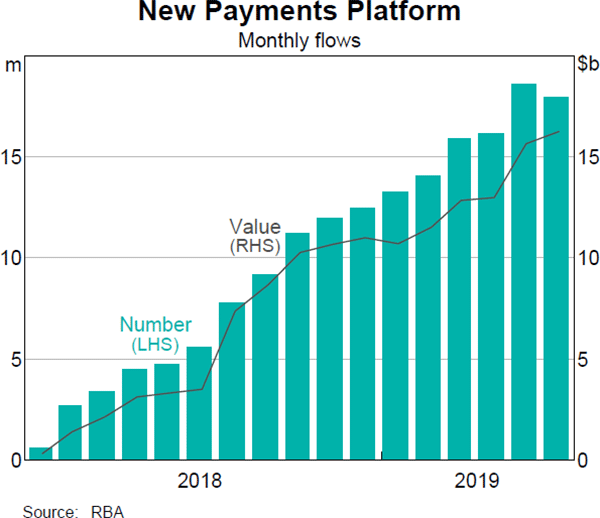
While NPP transaction amounts are still very low compared with other retail payment systems in Australia, the adoption of the NPP is proceeding at least as quickly as occurred for some comparable fast payment systems that were launched in other countries (Graph 10).
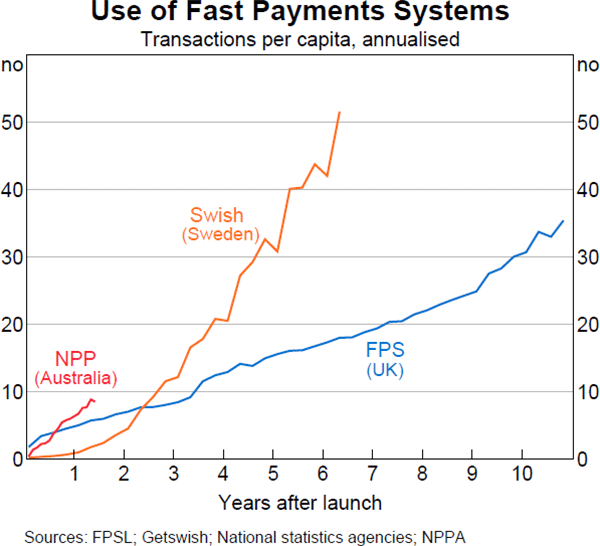
As noted earlier, some banks have begun to migrate some of their direct credit payments to the NPP (such as ‘pay anyone’ transfers), which helps explain the relatively high average NPP transaction value of around $850. Moreover, it is expected that other Direct Entry payments could migrate over time. For example, the industry is discussing building a ‘consent and mandate service’ for the NPP, which could facilitate recurring NPP payments as an alternative to direct debits through the Direct Entry system. A number of other capabilities are also being developed for the NPP so that it can be used for a range of other payment use cases.[8]
Cheque payments
Cheque use in Australia continues to decline at a rapid rate as consumers and businesses transition to more convenient electronic payment methods (Graph 11). In 2018/19, the total number and value of cheque payments decreased by 25 per cent and 35 per cent, respectively. There were less than 2.4 cheque transactions per person in the year (compared with around 45 per person in the mid 1990s) and the number of cheque payments is now less than ½ per cent of all non-cash payments. There was a particularly large decline in the value of financial institution (bank) cheques in 2018/19 as a result of e-conveyancing systems such as Property Exchange Australia (PEXA) becoming mandatory for certain transactions in NSW, Victoria, and Western Australia. This trend is expected to continue as other states and territories move towards e-conveyancing systems. The NPP, with its speed and rich data capabilities, could also provide a superior alternative to cheques in other use cases.
As cheque use declines, the per-transaction cost of supporting the cheque system will continue to rise. This is likely to prompt more businesses and other payees to stop accepting cheques. Given this trend, it will be appropriate at some point to close down the cheque system. The Australian Payments Council recently developed a strategy for managing the decline of the cheque system, which recommended a collaborative approach by industry to support the payment needs of remaining cheque users during the transition to electronic payment methods. AusPayNet is undertaking several initiatives to support this strategy, including customer education and advocating for the removal of the few remaining formal requirements for cheques to be used.
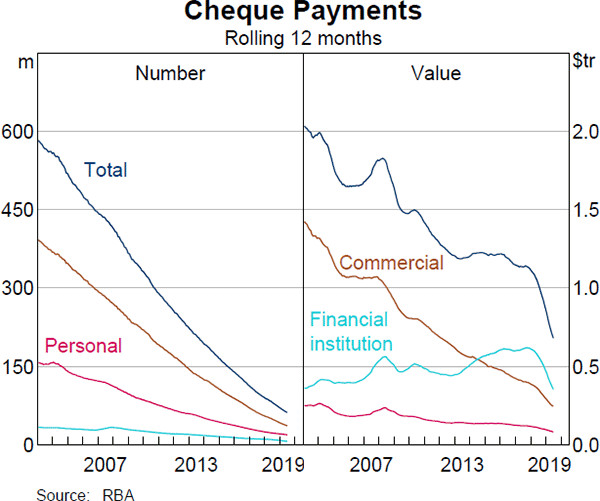
Payment fraud
According to data collected by AusPayNet, total losses related to fraudulent payment transactions increased by 2 per cent in 2018, to about $660 million – a slower rate of growth than in the few years prior (Graph 12, left panel). Fraud losses from international scheme cards (which includes transactions on debit, credit and charge cards that are issued and/or acquired in Australia) rose by about 3 per cent. In contrast, fraud losses from eftpos proprietary cards (which are not currently used for remote transactions), ATM transactions and cheques all declined in 2018. Historically, nearly all fraud losses have been incurred on international scheme cards, and the estimated fraud loss rate for these cards (currently about 110 cents per $1,000 transacted) is much higher than for the other payment types (2 cents per $1,000 transacted) (Graph 12, right panel).
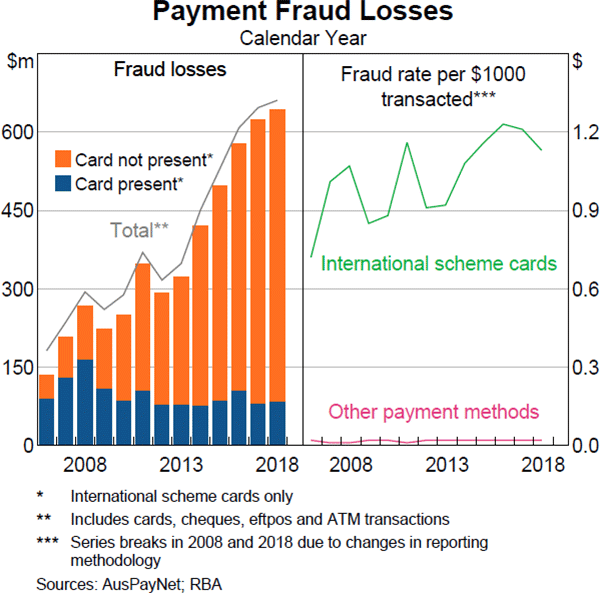
The driver of card fraud losses in recent years has been the fraudulent use of international scheme cards for card-not-present (CNP) transactions (i.e. those undertaken online, by phone or mail order). Losses from this type of fraud increased by a further 3 per cent in 2018, to around $560 million. Around 60 per cent of CNP fraud losses in 2018 occurred at Australian merchants (on both Australian and overseas-issued cards), with the remainder perpetrated overseas using Australian-issued cards. The industry has been working to reduce CNP fraud given rising losses and the expected continued growth in online card transactions. An industry framework to mitigate CNP fraud was recently developed by AusPayNet and came into effect in July 2019. The core feature of the framework is a requirement for multi-factor authentication of the cardholder in online CNP transactions where either merchants or issuers consistently exceed specified fraud thresholds (for further details see the ‘Retail Payments Regulation and Policy Issues’ chapter).
Card-present (CP) fraud losses from international scheme cards are lower than they were a decade ago. The introduction of enhanced security measures, such as chip-and-PIN, has helped reduce fraud losses from counterfeit and card skimming. However, CP fraud committed with lost and stolen cards has been growing in recent years, and rose substantially again in 2018 (by 32 per cent) to $55 million. The rise in this type of fraud has likely been facilitated by tap-and-go payments that do not require a PIN for transactions below $100.
Innovation in retail payments and new market entrants
Innovation in the provision of retail payments in Australia in recent years has been spurred by advances in digital technology (such as those associated with the internet, mobile devices and data processing) and the entry of new firms into the payments market, including ‘big tech’ conglomerates and smaller ‘fintechs’. Much of the innovation by these firms has been to the ways in which people make payments and the types of payment services provided, amid changing customer expectations about the ease of using different payment methods. Other initiatives have focused on improving the security of payments. In most cases, these new players still rely on the existing payment system infrastructure and payments system participants to facilitate payments in Australia.
One prominent example of technology firms' entry into the retail payment market over recent years has been the launch of mobile payment platforms, or digital wallets, such as those offered by Apple, Google and Samsung. These are applications on smartphones and other mobile devices that store electronic representations of payment cards that can be used to make contactless payments at the point-of-sale using the near-field communication (NFC) or quick response (QR) code functionality of the mobile device to communicate with a payment terminal. Mobile payment applications offer convenience and security to cardholders. While point-of-sale transactions using digital wallets were less than 1 per cent of consumer payments at the time of the Bank's last CPS in 2016, this share has likely increased since then as more card issuers have begun to support the use of their cards in digital wallets. The Bank will be gathering further information on the use of digital wallets for payments in its next CPS later this year.
‘Buy now, pay later’ (BNPL) services are another technology-enabled payment method that has expanded rapidly in recent years. These are services in which customers are able to purchase goods or services but defer payment via low- or zero-interest instalments to the BNPL provider, typically over 1–2 months. These services have become widely accepted by merchants in a number of retail segments, both online and in person. Data from several large BNPL providers indicates that the value of BNPL transactions has grown considerably in the past few years (Graph 13). The number of providers and products in the BNPL sector has also expanded during this period.
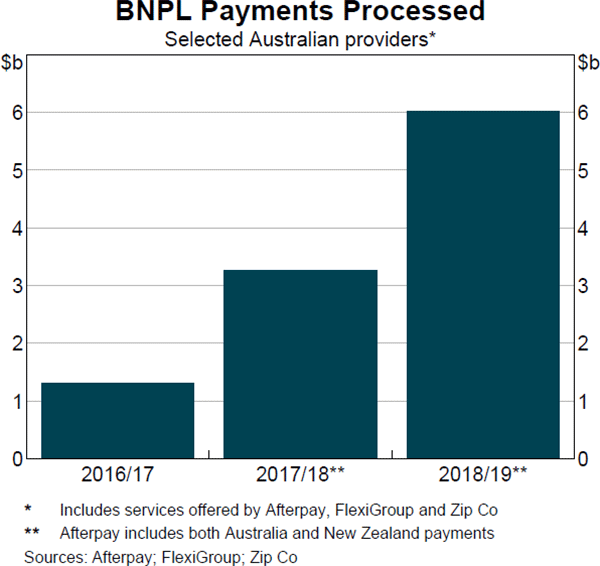
From a consumer perspective, the popularity of BNPL services may relate to their convenience and potentially providing a lower-cost alternative to consumer credit. There are indications that BNPL services are used more intensively by certain segments of the population, particularly younger people, who may not have a credit card. A recent study by ASIC indicates that more than 60 per cent of BNPL users are aged between 18 and 34.[9] For merchants, BNPL services may be attractive because they may facilitate increased sales. In addition, as merchants are paid upfront by the BNPL provider, they do not bear the risk of fraud or customer non-payment. However, merchants pay fees to the BNPL provider that are typically much higher than the fees they would pay on other payment methods, such as credit and debit cards. Most BNPL providers also have rules that prevent merchants from levying a surcharge on the customer to recover those fees. This can be problematic for merchants that feel compelled to offer BNPL services as a payment option for competitive reasons, but are unable to recoup the merchant fees from the customers that directly benefit from the service. The Bank will be considering if there are any policy issues associated with the growth of BNPL services as part of its 2020 review of card payments regulation.
Innovation and the entry of new tech-driven players have also occurred in the market for international money transfers. Traditionally, international money transfers have been processed through the correspondent banking network, whereby an individual payment may be intermediated by several banks before reaching its destination. Given the involvement of multiple intermediaries, these cross-border payments have typically been much slower and costlier to complete than domestic payments, with little transparency about the status of the payment at any given time. In recent years, a number of new market entrants have sought to address these limitations. A common business model involves the provider maintaining bank accounts in both the sending and receiving countries, which means a money transfer can be implemented without a chain of international intermediaries (which can be the case with a correspondent banking model). In addition, most new providers offer online-only services, which further reduces their operating costs relative to banks and other incumbent providers. While the new providers account for only a small share of the Australian cross-border payments market, some have experienced strong growth in transactions in recent years. With the number of people seeking to make cross-border payments rising, the Bank is planning to devote more attention to cross-border payments as part of its mandate to promote competition and efficiency in the payments system (see the chapter on ‘Strategic Priorities’).
Crypto-assets are another financial innovation that has attracted considerable interest in recent years.[10] Bitcoin and the large number of other crypto-assets that have followed it were largely designed to be electronic payment mechanisms that do not rely on the involvement of a central party like a bank to verify and record transactions. They are often touted as being an efficient, anonymous and borderless way of making payments. However, in practice, no crypto-assets have been widely adopted as a means of payment and there are very few merchants that accept them as a means of payment. Instead, demand for crypto-assets has mostly been focused on their use as a speculative investment, and this has likely contributed to the significant volatility in their prices. The Bank's assessment is that existing crypto-assets like Bitcoin do not meet the usual attributes of money and have various shortcomings that prevent them from becoming more widely used for everyday payments.[11] Besides price volatility, which means they are not a good store of value, there are issues around scalability and uncertainty about settlement finality that remain key barriers to widespread adoption.
In recent years, newer crypto-assets have been launched that attempt to address some of these shortcomings. For example, a number of so-called ‘stablecoins’ have emerged that seek to minimise price volatility by anchoring the token to a reference asset (such as a sovereign currency or gold) or a basket of assets. In some cases, these rely – often unsuccessfully – on an algorithmic approach that attempts to maintain the value of the coins by managing the supply to match demand, such that the market price tracks the underlying reference asset closely. Alternatively, some stablecoins have been able to achieve this by having their coins on issue fully backed by the reference asset. Even so, the use of these stablecoins has still been fairly limited to date. However, some observers have suggested that recent high-profile stablecoin initiatives of large financial institutions and technology companies (including the ‘Libra’ initiative being developed by a consortium that includes Facebook, Mastercard, Visa, PayPal and others) could become more widely adopted (see the chapter on ‘Retail Payments Regulation and Policy Issues’ for further discussion of Libra).
High-value Payment and Settlement Systems
In Australia, the final settlement of AUD interbank payment obligations occurs across Exchange Settlement (ES) accounts through the Reserve Bank Information and Transfer System (RITS). RITS facilitates settlement of payments on a real-time gross settlement (RTGS) basis. Foreign exchange transactions involving the AUD are generally settled through CLS Bank International (CLS), with AUD funding paid to CLS through RITS. Together these two systems settle the majority of payments in Australia by value.
Reserve Bank Information and Transfer System
RITS is Australia's high-value payments system, which is used by banks and other approved institutions to settle their payment obligations on a RTGS basis. RITS is used each day to also settle time-critical wholesale payments for other financial market infrastructures (FMIs): AUD pay-ins to or pay-outs from CLS; margin payments to central counterparties (CCPs); and debt and equity settlement obligations arising in securities settlement systems. Securities settlement involves delivery of the security in exchange for payment, typically through a securities settlement facility (SSF). RITS also settles the interbank obligations arising from non-cash retail payments. Over the past financial year average daily volumes and values of RTGS transactions in RITS increased broadly in line with the longer term trends (Table 4 and Graph 14).
RITS also facilitates the multilateral net settlement of interbank obligations arising from other systems. Multilateral net settlement involves the settlement of net obligations among three or more parties. This includes the settlement of obligations from non-cash retail payments – such as cheques, Direct Entry payments and card transactions – most of which are netted among participating financial institutions and sent through the RITS Low Value Settlement Service for multilateral net settlement.
| Number(b) | Annual Growth | Value(b) | Annual Growth | Interbank settlement value in RITS | Annual Growth | |
|---|---|---|---|---|---|---|
| ‘000s | (per cent) | $ billion | (per cent) | $ billion | per cent | |
| RITS RTGS | 50 | 5 | 198 | 10 | 192 | 9 |
| SWIFT payments | 46 | 5 | 117 | 9 | 117 | 8 |
| Austraclear(c) | 4 | 4 | 68 | 15 | 62 | 13 |
| RITS cash transfers | – | – | 13 | −6 | 13 | −6 |
| CLS | 74 | 25 | 324 | 15 | 3 | −2 |
| Retail payments | 52,057 | 11 | 45 | 5 | 6 | 7 |
| Direct Entry(d) | 12,667 | 5 | 40 | 9 | – | – |
| Cheques | 239 | −25 | 3 | −35 | – | – |
| Credit/Charge cards | 11,613 | 11 | 1 | 12 | – | – |
| Debit cards | 27,538 | 15 | 1 | 15 | – | – |
| Equity settlements(e) | – | – | 9 | 12 | 1 | 5 |
| Property settlements (PEXA)(f) |
2 | 110 | 2 | 150 | 1 | 150 |
| NPP | 600 | – | 0.5 | – | 0.3(g) | – |
|
(a) Business days (NPP payments made over seven days but expressed as an average per business day for comparability) Sources: ASX; CLS; RBA |
||||||
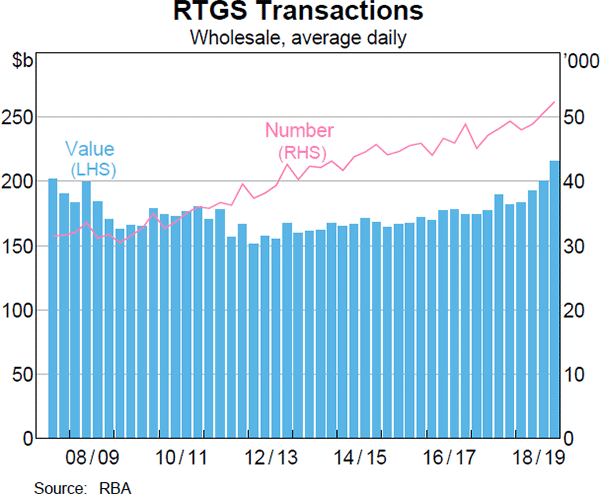
Direct Entry payments account for the majority of the value of retail payments through RITS. RITS also accepts transactions which are netted outside RITS: cash equity transactions through CHESS, ASX Settlement Pty Limited's (ASX Settlement) equities settlement system; Mastercard's AUD domestic obligations; eftpos scheme obligations; and property settlement transactions, managed by PEXA. Batch settlement values have grown very strongly in the past two financial years due largely to property settlement activity by PEXA (Table 4 and Graph 15). The payments for PEXA property transactions are submitted into RITS as multilateral net batches that settle once the property transfer has been confirmed by the land titles office.
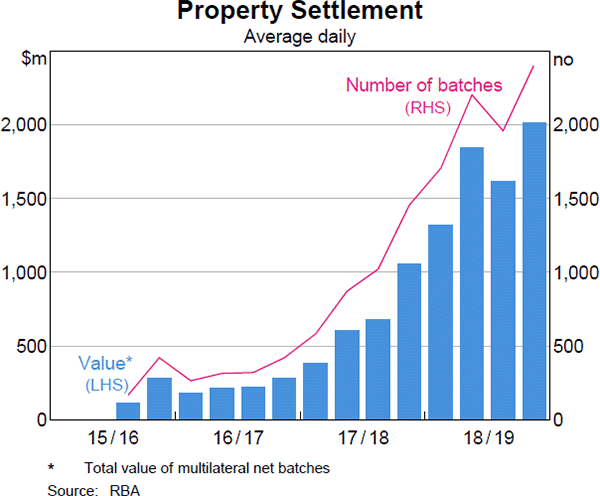
The Fast Settlement Service (FSS), which operates as a separate service of RITS, was publicly launched with the NPP in February 2018. It settles retail transactions submitted via NPP on an RTGS basis. Average daily settlement values in the FSS have steadily increased over the year, consistent with the rate of growth in NPP transaction values (Graph 9).
CLS Bank International
CLS is an international settlement system that links the settlement of the two legs of a foreign exchange transaction. By operating such a payment-versus-payment settlement mechanism, CLS allows participants to mitigate foreign exchange settlement risk, i.e. the risk that one counterparty to a transaction settles its obligation in one currency, but the other counterparty does not settle its obligation in the other currency. CLS currently settles 18 currencies. The daily average value of AUD settlements at CLS increased to around $324 billion this year consistent with a rise in the average daily turnover in the Australian dollar.
Securities settlement facilities
In Australia, ASX Settlement provides SSF services for ASX-quoted cash equities, debt products and warrants traded on the ASX and Chi-X Australia Pty Ltd (Chi-X) markets. ASX Settlement also provides SSF services for non-ASX listed securities quoted on the National Stock Exchange of Australia and the Sydney Stock Exchange Limited. The average daily value of cash equity settlements through ASX Settlement increased by around 11 per cent in 2018/19 to $9.1 billion.
Austraclear Limited (Austraclear) provides SSF services for trades in debt securities, including government bonds and repurchase agreements. Over the past year, the average daily value of debt securities settled in Austraclear increased by 17 per cent, to $56 billion.
Central counterparties
CCPs play a major role managing the risks associated with trading in financial instruments. CCPs stand between the counterparties to a financial trade, acting as the buyer to every seller and seller to every buyer; this activity is known as clearing. Participants in cleared markets have credit and liquidity exposures only to the CCP, rather than other participants in the market.
In the absence of a participant default, the CCP is not exposed to market risk as it stands between counterparties with opposite (i.e. offsetting) positions. However, in the event that a participant defaults, the CCP must continue to meet its obligations to its surviving participants. In such an event, the CCP faces potential losses from changes in the value of a defaulting participant's portfolio until it closes out the positions in that portfolio.
To mitigate the risk of such losses, CCPs maintain prefunded resources, typically in the form of initial margin and default funds. Initial margin, which is collected from participants, is sized to cover potential future losses (to a specified confidence interval) on a participant's portfolio in the event they default. Accordingly, initial margin provides a risk-based measure of the magnitude of exposures faced by CCPs. Default funds (comprising contributions from participants and/ or the CCP itself) are available to cover losses if, in the event of default, the defaulting participant's margin is exhausted.[12]
Four CCPs are licensed to provide services in Australia:
- ASX Clear Pty Limited (ASX Clear) provides CCP services for ASX-quoted cash equities, debt products and warrants traded on the ASX and Chi-X markets and equity-related derivatives traded on the ASX market or over-the-counter (OTC).
- ASX Clear (Futures) Pty Limited (ASX Clear (Futures)) provides CCP services for futures and options on interest rate, equity, energy and commodity products traded on the ASX 24 market, as well as AUD and NZD-denominated OTC interest rate derivatives (IRD).
- LCH Limited's (LCH Ltd) SwapClear service provides CCP services for OTC IRD and inflation rate derivatives.
- Chicago Mercantile Exchange Inc. (CME) is licensed to provide CCP services for OTC IRD, and non-AUD IRD traded on the CME market or the Chicago Board of Trade market for which CME permits portfolio margining with OTC IRD. In February, CME's licence was varied to permit the provision of clearing services for 13 AUD-denominated cash-settled power and USD-denominated cash-settled commodity futures and option contracts to be traded on the financial market operated by FEX Global Pty Ltd (FEX). The service is expected to launch in the coming months.
Exchange-traded products
The ASX CCPs clear exchange-traded futures and options, as well as cash equities. Notional values outstanding in the three largest interest rate futures contracts increased strongly through 2018/19 (Graph 16). Total trading activity in interest rate futures in the June quarter of 2019 was 11 per cent higher than in the June quarter of 2018. The notional value of ASX SPI200 futures outstanding fluctuated in 2018/19 to also be higher over the year, but the notional value of equity exchange-traded options (ETOs) declined (Graph 17). Turnover in cash equities also grew over 2018/19 (Graph 18).
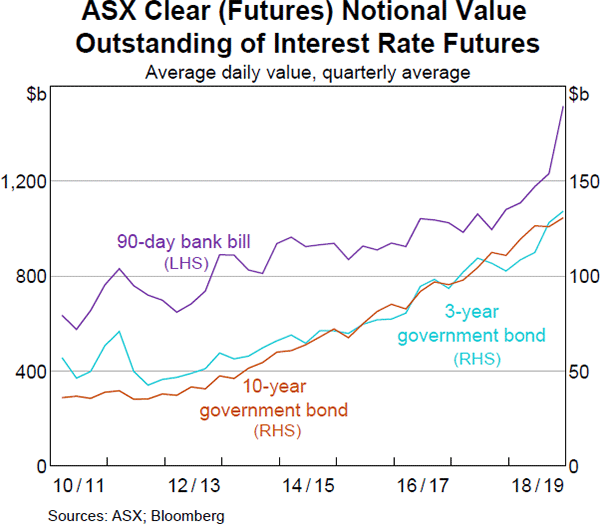
Interest rate futures and the ASX SPI200 futures comprise the majority of exposures, as measured by initial margin, at ASX Clear (Futures). These exposures increased in 2018/19 (Graph 19), reflecting growth in the notional value outstanding across the major contracts and an increase in margin rates charged on SPI200 and Treasury bond futures. Initial margin also increased substantially in early 2019 as a result of the reallocation of client positions between accounts, which resulted in higher margin requirements due to a loss of netting benefits.
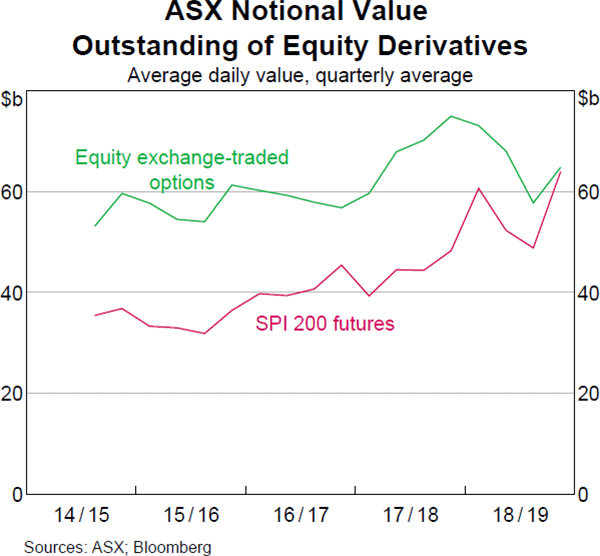
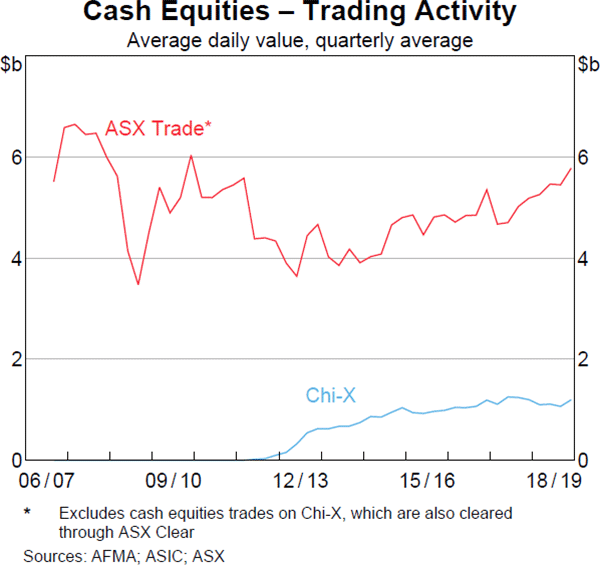
ASX Clear manages exposures from its participants’ trades in cash equities and equity ETOs (other than the ASX SPI200 futures). Exposures from cash equity transactions are typically much lower than for equity derivatives because of the short duration of cash security trades at two days. ASX Clear's total exposures, as measured by margin, increased in 2018/19, reflecting a rise in equity index option positions (Graph 20).
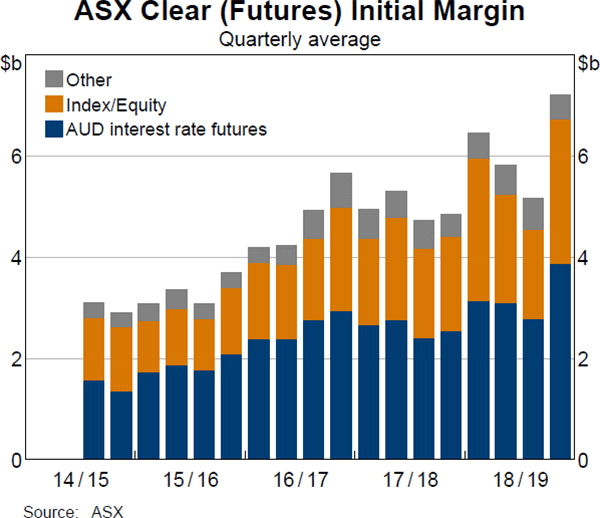
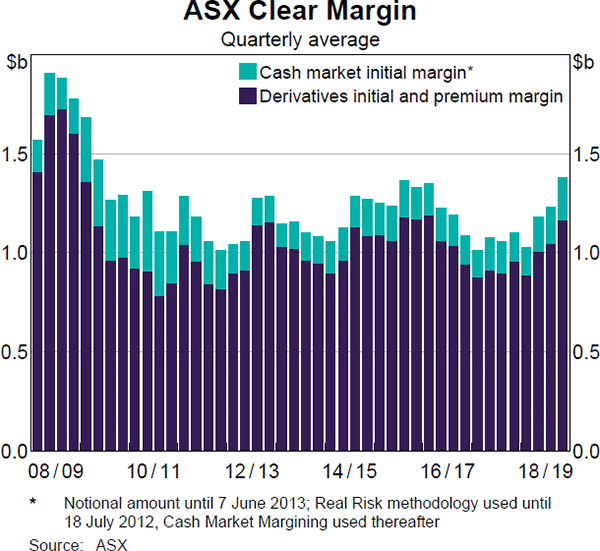
Over-the-counter interest rate derivatives
There has been rapid growth in the proportion of OTC IRD that are centrally cleared. Consistent with the G20's OTC derivatives reforms, mandatory central clearing of OTC IRD between internationally active dealers came into effect in Australia in April 2016; this applied to IRD denominated in AUD and the major currencies. Other regulations, such as higher margin and capital requirements for OTC derivatives that are not cleared, and factors such as increased liquidity and netting benefits, have also provided incentives for firms to clear more of their derivatives. Prior to 2012, Australian banks cleared almost none of their IRDs, whereas they now clear over 85 per cent of their single-currency interest-rate swaps (Graph 21).
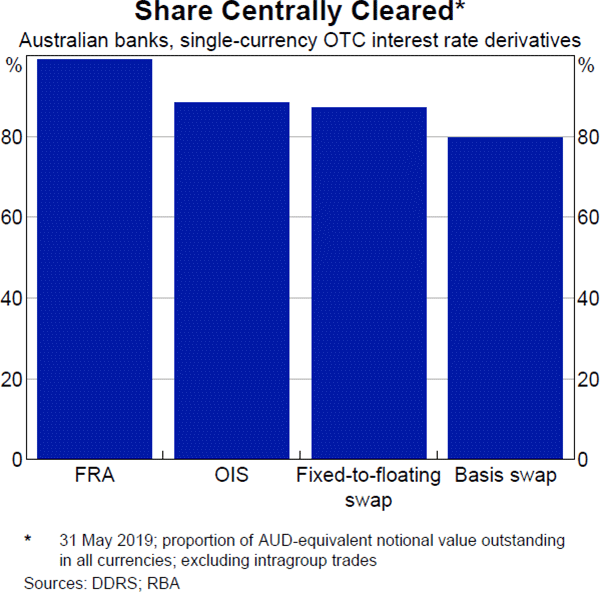
ASX Clear (Futures), CME and LCH Ltd all offer central clearing for AUD-denominated IRD. As at June 2019, 84 per cent of centrally cleared AUD OTC IRD outstanding were cleared at LCH Ltd, with most of the remaining share cleared at ASX Clear (Futures) (Graph 22). Interest rate swaps and overnight index swaps (OIS) account for the majority of outstanding AUD positions, while basis swaps, zero-coupon swaps and variable notional swaps are also cleared. The notional value of all centrally cleared AUD-denominated OTC IRD increased significantly in 2019. This was driven by activity in OIS (short-term interest rate swaps tied to the cash rate), consistent with strong growth in activity in the 90-day bank bill futures contract, and was attributed to changing expectations regarding the likely path of the cash rate. Activity in OIS is typically more volatile than other interest rate swaps, although they contribute significantly less to risk exposures because they are relatively short-term in duration.
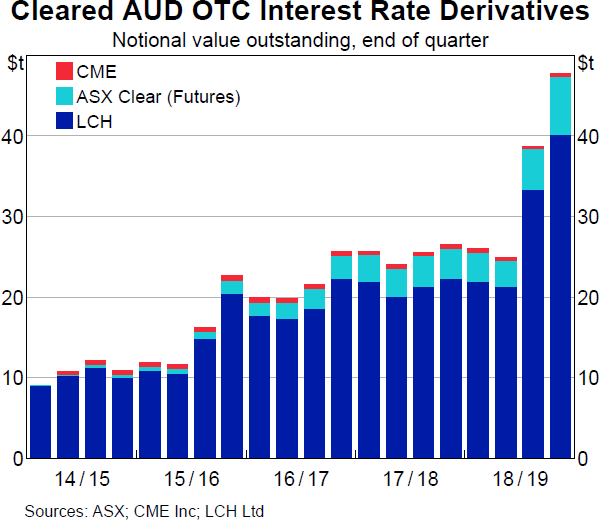
ASX Clear (Futures) provides clearing services for AUD- and NZD-denominated IRD, while LCH Ltd and CME provide clearing services for OTC IRD in a broader range of currencies. AUD-denominated contracts make up a small share of outstanding contracts in all currencies – around 8 per cent at LCH Ltd's SwapClear service and less than 1 per cent at CME as at the end of June.
ASX Clear (Futures) has eight participants in its OTC service and SwapClear has six Australian-incorporated entities participating directly, while CME has no Australian direct participants. A number of Australian-based banks, superannuation funds and other institutional investors clear products at all three CCPs indirectly, as clients of other direct participants.
The notional value of OTC IRD trades registered in all currencies increased at both LCH and CME over 2018/19 (Graph 23). Growth in exposures, as measured by initial margin, increased at a slower pace than trades registered. One reason for the difference in growth between trades registered and exposures is that new trades often offset participants' existing or new positions. Participants can eliminate these offsetting positions through the use of compression services, with the effect that the notional value of outstanding OTC IRD positions is growing more slowly than measures of activity such as trades registered.
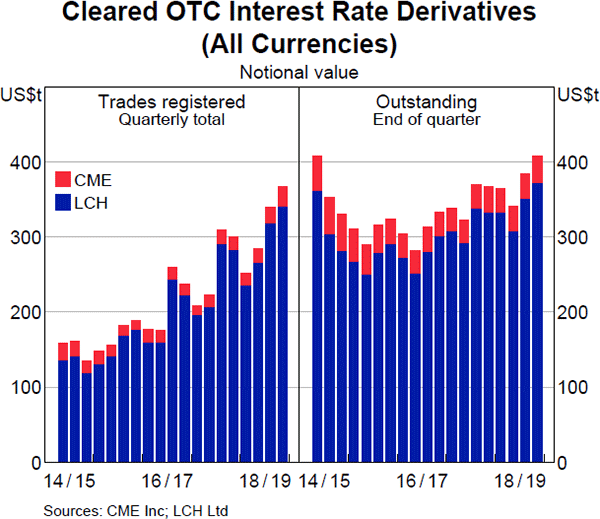
Footnotes
Wakefield, M and R Finlay (2018), ‘Understanding Demand for Australia's Banknotes’, RBA Bulletin, December, viewed 16 August 2019. Available at <https://www.rba.gov.au/publications/bulletin/2018/dec/understanding-demand-for-australias-banknotes.html>. [6]
For more information on the publication of these new series, see Mitchell S and H Wang (2019), ‘New Payments Insights from the Updated Retail Payments Statistics Collection’, RBA Bulletin, March, viewed 16 August 2019. Available at <https://www.rba.gov.au/ publications/bulletin/2019/mar/new-payments-insights-from-the-updated-retail-payments-statistics-collection.html>. The relevant statistical tables C1–C2.2 are available on the Bank's website at <https://www.rba.gov.au/statistics/tables/>. [7]
See Box A in RBA (2019), ‘New Payments Platform Functionality and Access Consultation Conclusions Paper’, June. Available at <https://www.rba.gov.au/payments-and-infrastructure/new-payments-platform/functionality-and-access-report.html>. [8]
Australian Securities and Investments Commission (2018), ‘Review of Buy Now Pay Later Arrangements’, Report 600, November. [9]
Crypto-assets are sometimes also described as cryptocurrencies or crypto-tokens. [10]
See Dark C, D Emery, J Ma and C Noone (2019), ‘Cryptocurrency: Ten Years On’, RBA Bulletin, June, viewed 16 August 2019. Available at <https://www.rba.gov.au/publications/bulletin/2019/jun/cryptocurrency-ten-years-on.html>. [11]
CCPs also call variation margin to cover the exposure to actual changes in market prices, to prevent the build-up of current exposures. It is collected from participants with mark-to-market losses, and typically paid out to participants with gains. [12]